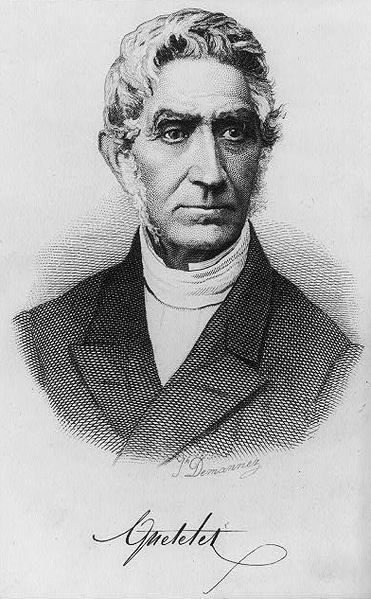<Back to Index>
- Astronomer Lambert Adolphe Jacques Quetelet, 1796
- Painter Rembrandt Peale, 1778
- King of France Charles VII, 1403
PAGE SPONSOR

Lambert Adolphe Jacques Quetelet (22 February 1796 – 17 February 1874) was a Belgian astronomer, mathematician, statistician and sociologist. He founded and directed the Brussels Observatory and was influential in introducing statistical methods to the social sciences. His name is sometimes spelled with an accent as Quételet.
Lambert Adolphe Jacques Quetelet was born in Ghent, Belgium, on 22 February 1796. He studied at the lycée in Gent, where he started teaching mathematics in 1815, at the age of 19. In 1819 he moved to the athenaeum in Brussels and in the same year he completed his dissertation (De quibusdam locis geometricis, necnon de curva focal – Of some new properties of the focal distance and some other curves).
Quetelet received a doctorate in mathematics in 1819 from the University of Ghent. Shortly thereafter, the young man set out to convince government officials and private donors to build an astronomical observatory in Brussels; he succeeded in 1828. He became a member of the Royal Academy in 1820. He lectured at the museum for sciences and letters and at the Belgian Military School. In 1850, he was elected a foreign member of the Royal Swedish Academy of Sciences. Quetelet also founded several statistical journals and societies, and was especially interested in creating international cooperation among statisticians.
In 1855 Quetelet suffered from apoplexy, which diminished but did not end his scientific activity. He died in Brussels on 17 February 1874.
His
scientific research encompassed a wide range of different scientific
disciplines: meteorology, astronomy, mathematics, statistics, demography, sociology, criminology and history of science. He made
significant contributions to scientific development, but he also wrote
several monographs directed to the general public. He founded the Royal Observatory of Belgium,
founded or co-founded several national and international statistical
societies and scientific journals, and presided over the first series
of the International Statistical Congresses. Quetelet was a liberal and
an anticlerical, but not an atheist or materialist nor a socialist. The new science of probability and statistics was mainly used in astronomy at the time, to get a handle on measurement errors with the method of least squares.
Quetelet was among the first who attempted to apply it to social
science, planning what he called a "social physics". He was keenly
aware of the overwhelming complexity of social phenomena, and the many
variables that needed measurement. His goal was to understand the
statistical laws underlying such phenomena as crime rates, marriage
rates or suicide rates. He wanted to explain the values of these
variables by other social factors. These ideas were rather
controversial among other scientists at the time who held that it
contradicted a concept of freedom of choice. His most influential book was Sur l'homme et le développement de ses facultés, ou Essai de physique sociale, published in 1835 (In English translation, titled Treatise on Man). In it, he outlines the project of a social physics and describes his concept of the "average man" (l'homme moyen) who is characterized by the mean values of measured variables that follow a normal distribution. He collected data about many such variables. When Auguste Comte discovered
that Quetelet had appropriated the term 'social physics', which Comte
had originally introduced, Comte found it necessary to invent the term
'sociologie' (sociology) because he disagreed with Quetelet's collection of statistics.
Quetelet was an influential figure in criminology. Along with Andre-Michel Guerry, he helped to establish the cartographic school and positivist schools of
criminology which made extensive use of statistical techniques. Through
statistical analysis, Quetelet gained insight into the relationships
between crime and other social factors. Among his findings were strong relationships between age and crime, as well as gender and crime. Other influential factors he found included climate, poverty, education, and alcohol consumption, with his research findings published in Of the Development of the Propensity to Crime. In
1835 he presented his theory of the average man in Sur I'homme et le
development de ses facultes, essai d'une physique social, which
measurements of human trait are grouped according to the normal curve. In terms of influence over later public health agendas
was Quetelet's establishment of a simple measure for classifying
people's weight relative to an ideal weight for their height. His
proposal, the body mass index (or Quetelet index), has endured with minor variations to the present day.
The Quetlet index was developed through the measurement of 5000
Scottish soldiers in 1844. Anthropoemtric data are used in modern applications and
referenced in the development of every consumer based product.